

Compact Muon Solenoid
LHC, CERN
| CMS-PAS-HIG-18-002 | ||
| Measurements of Higgs boson properties from on-shell and off-shell production in the four-lepton final state | ||
| CMS Collaboration | ||
| September 2018 | ||
|
Abstract:
Studies of on-shell and off-shell Higgs boson production in the four-lepton final state are presented, using data from the CMS experiment at the LHC that corresponds to an integrated luminosity of 80.2 fb−1 at 13 TeV. Joint constraints are set on the width of the Higgs and parameters that express its anomalous couplings to two electroweak vector bosons using both on-shell and off-shell production of the Higgs boson. These results are combined with results from the data collected at center-of-mass energies of 7 and 8 TeV, corresponding to integrated luminosities of 5.1 and 19.7 fb−1, respectively. Matrix element techniques, which combine kinematic information from the decay particles and the associated jets, are used to identify the production mechanism and to increase sensitivity to the Higgs boson signal and its anomalous couplings. The observations are consistent with expectations for a Standard Model Higgs boson. This document has been revised with respect to the version dated September 17, 2018. | ||
|
Links:
CDS record (PDF) ;
CADI line (restricted) ;
These preliminary results are superseded in this paper, PRD 99 (2019) 112003. The superseded preliminary plots can be found here. |
||
| Figures & Tables | Summary | Additional Figures | References | CMS Publications |
|---|
| Figures | |

png pdf |
Figure 1:
Three topologies of the H boson production and decay: vector boson fusion qq→VV(qq)→H(qq)→VV(qq) (left); associated production qq→V→VH→(ff)H→(ff)VV (middle); and gluon fusion gg→H→VV→4ℓ (right) representing the topology without associated particles. The incoming particles are shown in brown, the intermediate vector bosons and their fermion daughters are shown in green, the H boson and its vector boson daughters are shown in red, and angles are shown in blue. In the first two cases the production and decay H→VV is followed by the same four-lepton decay shown in the third case. The angles are defined in either the H or V boson rest frames [38,40]. |

png pdf |
Figure 1-a:
Vector boson fusion qq→VV(qq)→H(qq)→VV(qq), representing one topology of H boson production and decay. The incoming particles are shown in brown, the intermediate vector bosons and their fermion daughters are shown in green, the H boson and its vector boson daughters are shown in red, and angles are shown in blue. The decay H→VV is followed by the four-lepton decay. The angles are defined in either the H or V boson rest frames [38,40]. |

png pdf |
Figure 1-b:
Associated production qq→V→VH→(ff)H→(ff)VV, representing one topology of H boson production and decay. The incoming particles are shown in brown, the intermediate vector bosons and their fermion daughters are shown in green, the H boson and its vector boson daughters are shown in red, and angles are shown in blue. The decay H→VV is followed by the four-lepton decay. The angles are defined in either the H or V boson rest frames [38,40]. |
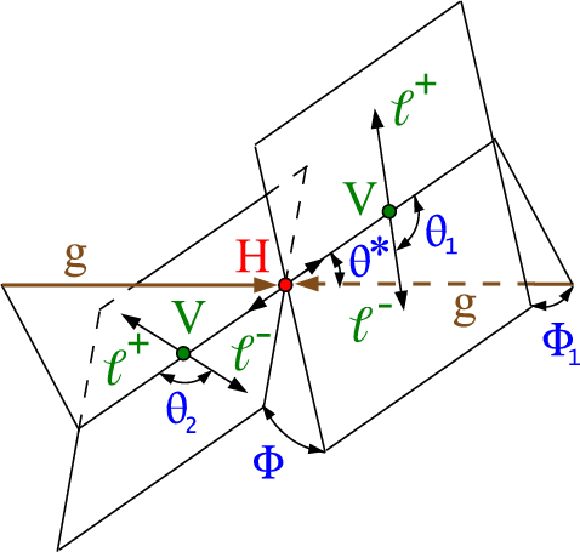
png pdf |
Figure 1-c:
Gluon fusion gg→H→VV→4ℓ, representing one topology of the H boson production and decay, without associated particles. The incoming particles are shown in brown, the intermediate vector bosons and their fermion daughters are shown in green, the H boson and its vector boson daughters are shown in red, and angles are shown in blue. The production and decay H→VV is followed by the four-lepton decay, as shown. The angles are defined in either the H or V boson rest frames [38,40]. |
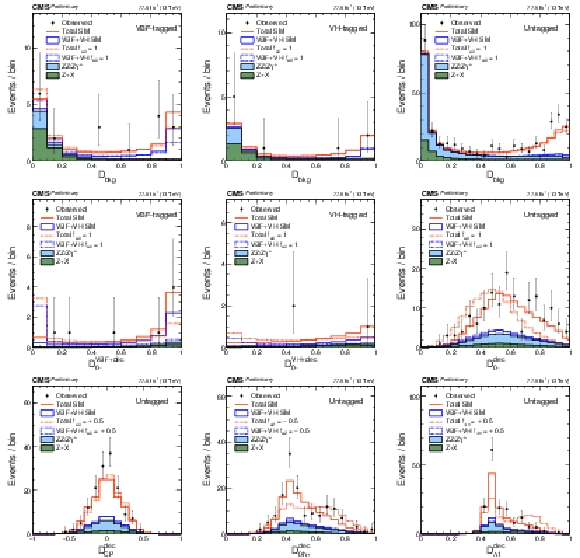
png pdf |
Figure 2:
The distributions of events in the on-shell region. The top row shows Dbkg in the VBF-tagged (left), VH-tagged (middle), and untagged (right) categories of the a3 analysis. The rest of the distributions are shown with the requirement Dbkg> 0.5 in order to enhance signal over background contributions. The middle row shows D0− in the corresponding three categories. The bottom row shows DdecCP of the a3, Ddec0h+ of the a2, and DdecΛ1 of the Λ1 analyses in the untagged categories. |
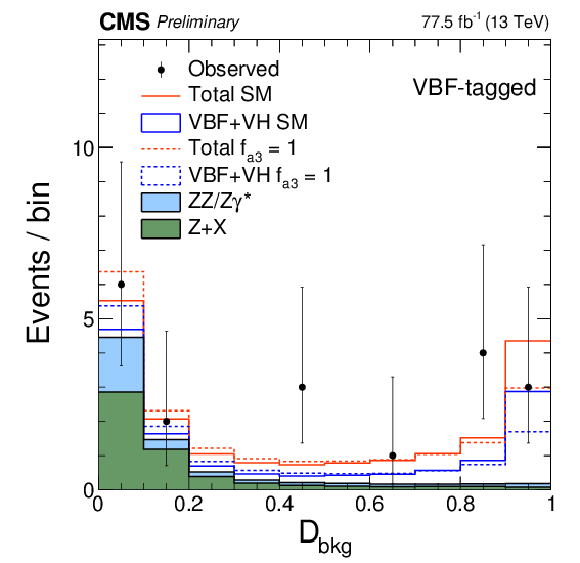
png pdf |
Figure 2-a:
Distribution of Dbkg in the VBF-tagged category of the a3 analysis for events events in the on-shell region. |
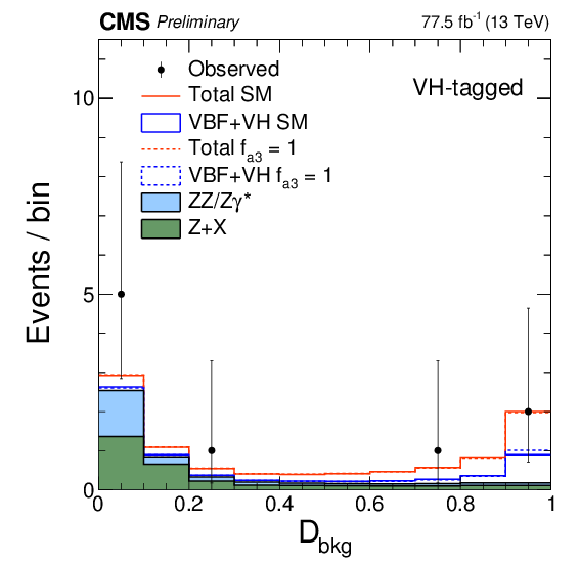
png pdf |
Figure 2-b:
Distribution of Dbkg in the VH-tagged category of the a3 analysis for events events in the on-shell region. |
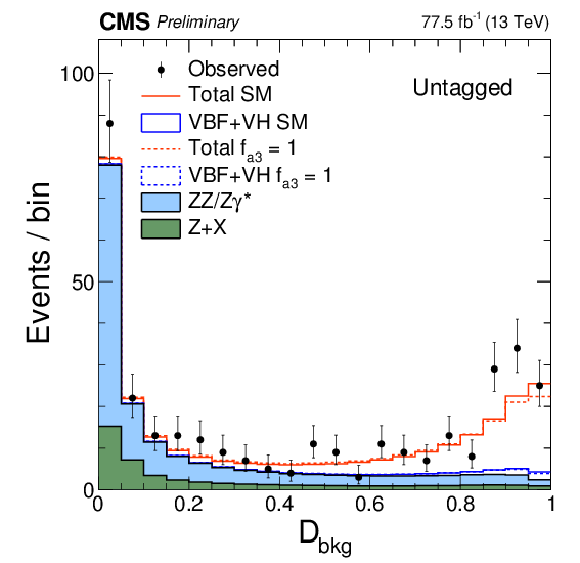
png pdf |
Figure 2-c:
Distribution of Dbkg in the untagged category of the a3 analysis for events events in the on-shell region. |

png pdf |
Figure 2-d:
Distribution of D0− in the VBF-tagged category of the a3 analysis for events events in the on-shell region. The distribution is shown with the requirement Dbkg>0.5 in order to enhance signal over background contributions. |

png pdf |
Figure 2-e:
Distribution of D0− in the VH-tagged category of the a3 analysis for events events in the on-shell region. The distribution is shown with the requirement Dbkg>0.5 in order to enhance signal over background contributions. |

png pdf |
Figure 2-f:
Distribution of D0− in the untagged category of the a3 analysis for events events in the on-shell region. The distribution is shown with the requirement Dbkg>0.5 in order to enhance signal over background contributions. |
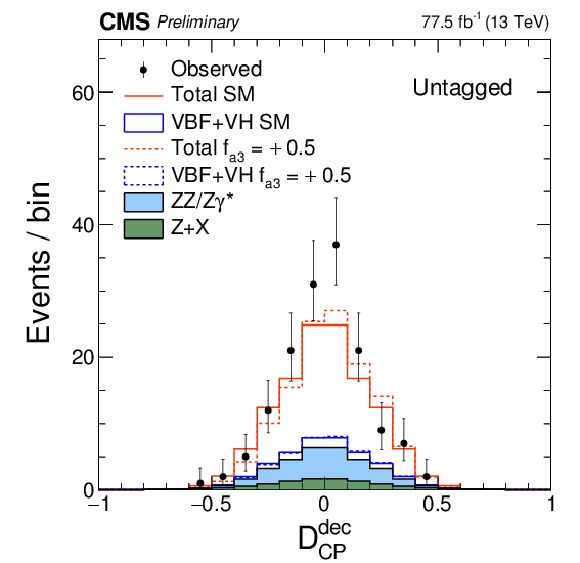
png pdf |
Figure 2-g:
Distribution of DdecCP of the a3 analysis in the untagged category, for events events in the on-shell region. The distribution is shown with the requirement Dbkg>0.5 in order to enhance signal over background contributions. |

png pdf |
Figure 2-h:
Distribution of Ddec0h+ of the a2 analysis in the untagged category, for events events in the on-shell region. The distribution is shown with the requirement Dbkg>0.5 in order to enhance signal over background contributions. |
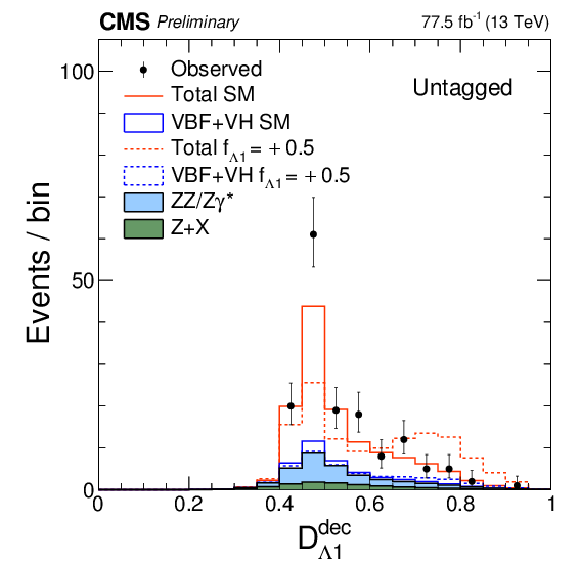
png pdf |
Figure 2-i:
Distribution of DdecΛ1 of the Λ1 analysis in the untagged category, for events events in the on-shell region. The distribution is shown with the requirement Dbkg>0.5 in order to enhance signal over background contributions. |
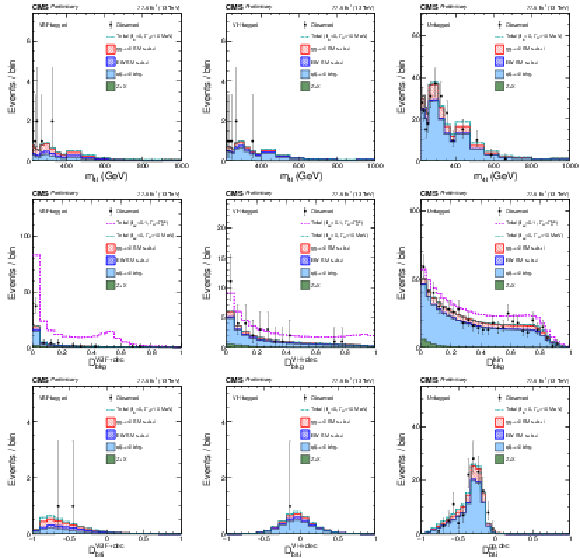
png pdf |
Figure 3:
The distributions of events in the off-shell region. The top row shows m4ℓ in the VBF-tagged (left), VH-tagged (middle), and untagged (right) categories in the dedicated SM-like width analysis where a requirement on DVBF+decbkg, DVH+decbkg, or Dbkg> 0.6 is applied in order to enhance signal over background contributions. The middle row shows DVBF+decbkg (left), DVH+decbkg (middle), Dkinbkg (right) of the a3 analysis in the corresponding three categories. The requirement m4ℓ> 340 GeV is applied in order to enhance signal over background contributions. The bottom row shows Dbsi in the corresponding three categories in the dedicated SM-like width analysis with both of the above requirements enhancing the signal contribution. |

png pdf |
Figure 3-a:
The distribution of m4ℓ for events in the off-shell region in the VBF-tagged category. The distribution is obtained in the dedicated SM-like width analysis where a requirement on DVBF+decbkg> 0.6 is applied in order to enhance signal over background contributions. |

png pdf |
Figure 3-b:
The distribution of m4ℓ for events in the off-shell region in the VH-tagged category. The distribution is obtained in the dedicated SM-like width analysis where a requirement on DVH+decbkg> 0.6 is applied in order to enhance signal over background contributions. |

png pdf |
Figure 3-c:
The distribution of m4ℓ for events in the off-shell region in the untagged category. The distribution is obtained in the dedicated SM-like width analysis where a requirement on Dbkg> 0.6 is applied in order to enhance signal over background contributions. |
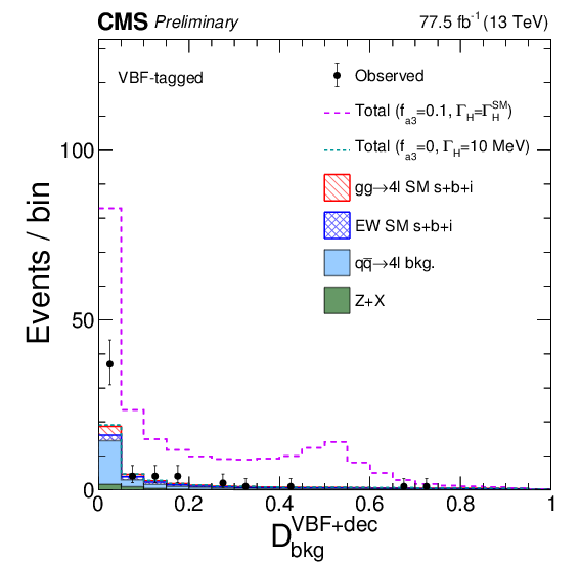
png pdf |
Figure 3-d:
The distribution of DVBF+decbkg of the a3 analysis, for events in the off-shell region in the VBF-tagged category. The requirement m4ℓ> 340 GeV is applied in order to enhance signal over background contributions. |
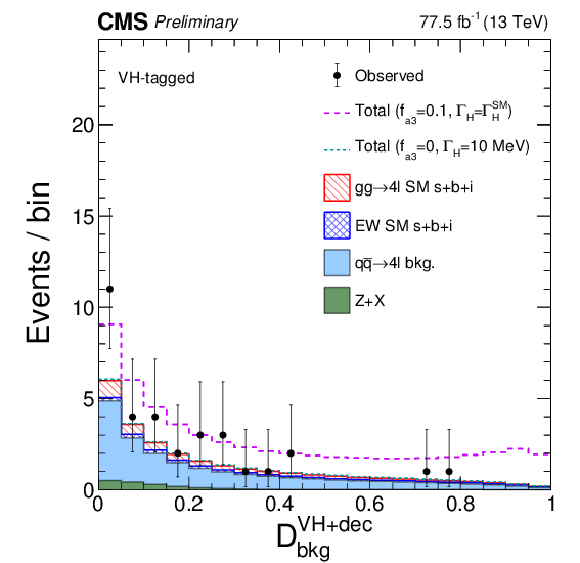
png pdf |
Figure 3-e:
The distribution of DVH+decbkg of the a3 analysis, for events in the off-shell region in the VH-tagged category. The requirement m4ℓ> 340 GeV is applied in order to enhance signal over background contributions. |
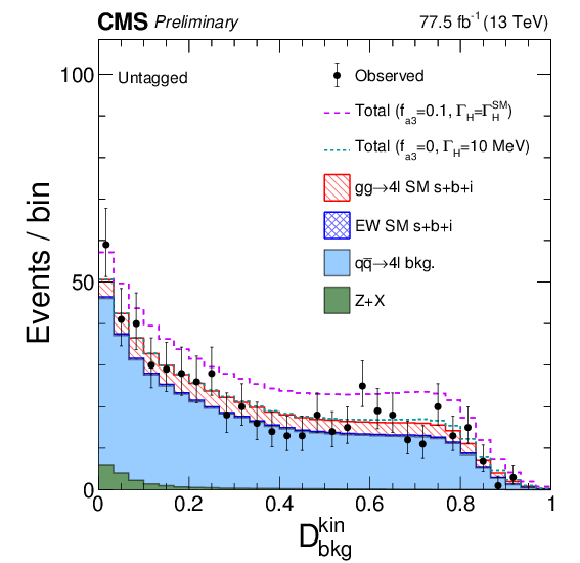
png pdf |
Figure 3-f:
The distribution of Dkinbkg of the a3 analysis, for events in the off-shell region in the untagged category. The requirement m4ℓ> 340 GeV is applied in order to enhance signal over background contributions. |

png pdf |
Figure 3-g:
The distribution of Dbsi for events in the off-shell region in the VBF-tagged category. The distribution is obtained in the dedicated SM-like width analysis where a requirement on DVBF+decbkg> 0.6, and the requirement m4ℓ> 340 GeV, are applied in order to enhance signal over background contributions. |

png pdf |
Figure 3-h:
The distribution of Dbsi for events in the off-shell region in the VH-tagged category. The distribution is obtained in the dedicated SM-like width analysis where a requirement on DVH+decbkg> 0.6, and the requirement m4ℓ> 340 GeV, are applied in order to enhance signal over background contributions. |

png pdf |
Figure 3-i:
The distribution of Dbsi for events in the off-shell region in the untagged category. The distribution is obtained in the dedicated SM-like width analysis where a requirement on Dbkg> 0.6, and the requirement m4ℓ> 340 GeV, are applied in order to enhance signal over background contributions. |
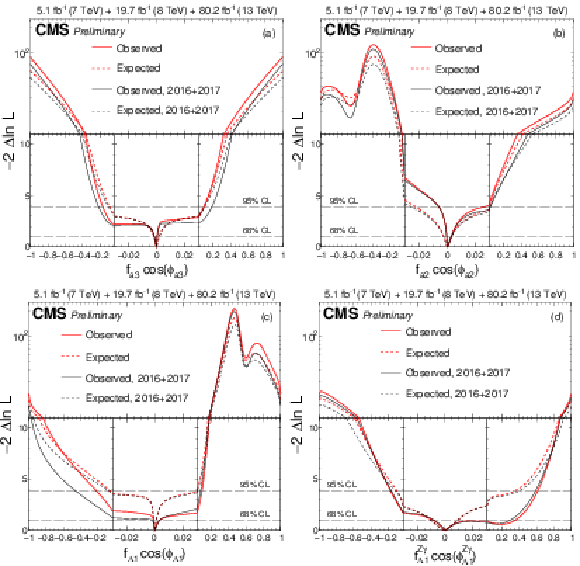
png pdf |
Figure 4:
Observed (solid) and expected (dashed) likelihood scans of fa3cos(ϕa3) (a), fa2cos(ϕa2) (b), fΛ1cos(ϕΛ1) (c), and fΛ1Zγcos(ϕΛ1Zγ) (d) using on-shell events only. Results of analysis of the data from 2016 and 2017 only (black) and the combined Run 1 and Run 2 analysis (red) are shown. The dashed horizontal lines show the 68% and 95% CL regions. |
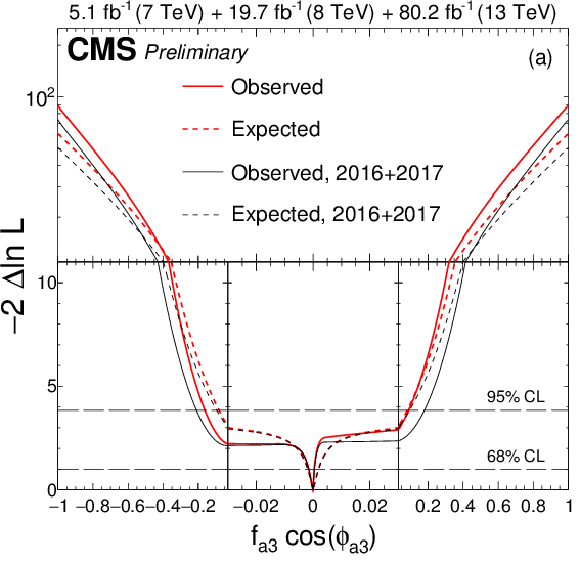
png pdf |
Figure 4-a:
Observed (solid) and expected (dashed) likelihood scans of fa3cos(ϕa3), using on-shell events only. Results of analysis of the data from 2016 and 2017 only (black) and the combined Run 1 and Run 2 analysis (red) are shown. The dashed horizontal lines show the 68% and 95% CL regions. |

png pdf |
Figure 4-b:
Observed (solid) and expected (dashed) likelihood scans of fa3cos(ϕa3), using on-shell events only. Results of analysis of the data from 2016 and 2017 only (black) and the combined Run 1 and Run 2 analysis (red) are shown. The dashed horizontal lines show the 68% and 95% CL regions. |

png pdf |
Figure 4-c:
Observed (solid) and expected (dashed) likelihood scans of fΛ1cos(ϕΛ1), using on-shell events only. Results of analysis of the data from 2016 and 2017 only (black) and the combined Run 1 and Run 2 analysis (red) are shown. The dashed horizontal lines show the 68% and 95% CL regions. |

png pdf |
Figure 4-d:
Observed (solid) and expected (dashed) likelihood scans of fΛ1Zγcos(ϕΛ1Zγ), using on-shell events only. Results of analysis of the data from 2016 and 2017 only (black) and the combined Run 1 and Run 2 analysis (red) are shown. The dashed horizontal lines show the 68% and 95% CL regions. |

png pdf |
Figure 5:
Constraints on fa3cos(ϕa3) (top), fa2cos(ϕa2) (middle), and fΛ1cos(ϕΛ1) (bottom) under the assumption ΓH=ΓSMH (left) and with ΓH unconstrained (right). Left plots: Results of analysis of the data from 2016 and 2017 only (black) and the combined Run 2 and Run 1 analysis (red) are shown. The dashed horizontal lines show the 68% and 95% CL regions. Observed (solid) and expected (dashed) likelihood scans are shown. Right plots: Observed 2D likelihood scans are shown for the combined Run 2 and Run 1 analysis. The 68% and 95% CL regions are indicated with the dashed lines. |
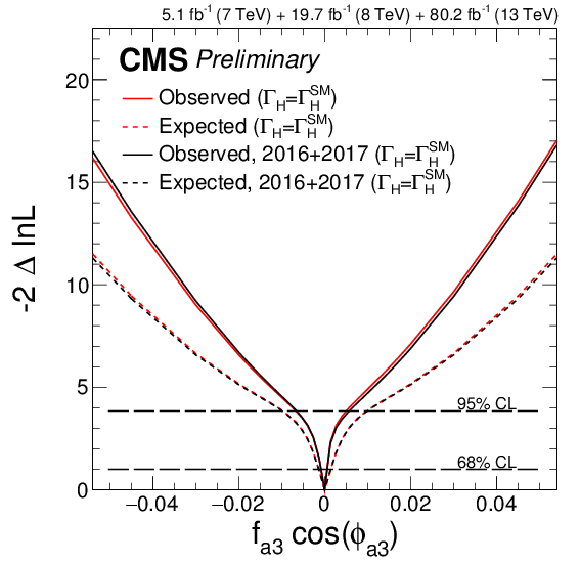
png pdf |
Figure 5-a:
Constraints on fa3cos(ϕa3), under the assumption ΓH=ΓSMH. Results of analysis of the data from 2016 and 2017 only (black) and the combined Run 2 and Run 1 analysis (red) are shown. The dashed horizontal lines show the 68% and 95% CL regions. Observed (solid) and expected (dashed) likelihood scans are shown. |

png pdf |
Figure 5-b:
Constraints on fa3cos(ϕa3), with ΓH unconstrained. Observed 2D likelihood scans are shown for the combined Run 2 and Run 1 analysis. The 68% and 95% CL regions are indicated with the dashed lines. |

png pdf |
Figure 5-c:
Constraints on fa2cos(ϕa2), under the assumption ΓH=ΓSMH. Results of analysis of the data from 2016 and 2017 only (black) and the combined Run 2 and Run 1 analysis (red) are shown. The dashed horizontal lines show the 68% and 95% CL regions. Observed (solid) and expected (dashed) likelihood scans are shown. |
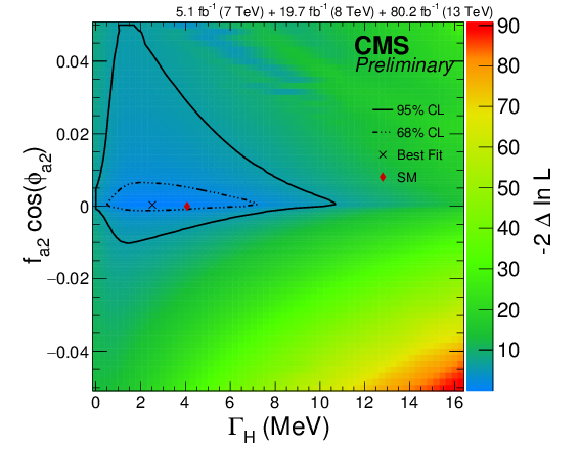
png pdf |
Figure 5-d:
Constraints on fa2cos(ϕa2), with ΓH unconstrained. Observed 2D likelihood scans are shown for the combined Run 2 and Run 1 analysis. The 68% and 95% CL regions are indicated with the dashed lines. |
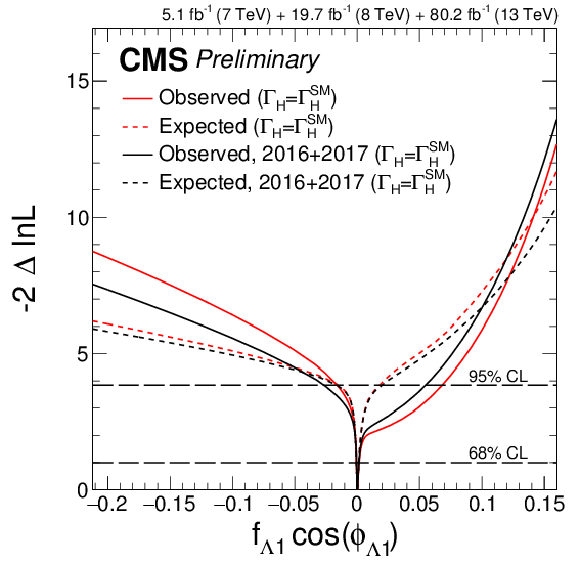
png pdf |
Figure 5-e:
Constraints on fΛ1cos(ϕΛ1), under the assumption ΓH=ΓSMH. Results of analysis of the data from 2016 and 2017 only (black) and the combined Run 2 and Run 1 analysis (red) are shown. The dashed horizontal lines show the 68% and 95% CL regions. Observed (solid) and expected (dashed) likelihood scans are shown. |

png pdf |
Figure 5-f:
Constraints on fΛ1cos(ϕΛ1), with ΓH unconstrained. Observed 2D likelihood scans are shown for the combined Run 2 and Run 1 analysis. The 68% and 95% CL regions are indicated with the dashed lines. |
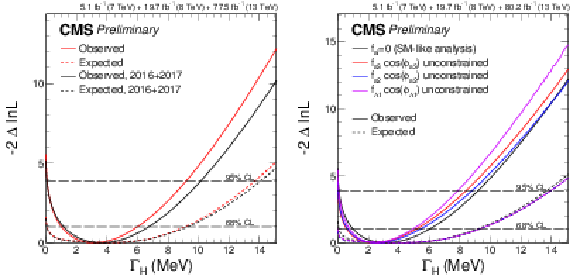
png pdf |
Figure 6:
Observed (solid) and expected (dashed) likelihood scans of ΓH. Left plot: Results of analysis of the data from 2016 and 2017 only (black) and the combined Run 1 and Run 2 analysis (red) are shown for the SM-like couplings. Right plot: Results of analysis of the data from the combined Run 1 and Run 2 analyses for the SM-like couplings and with three anomalous coupling parameters of interest unconstrained: fa3cos(ϕa3) (red), fa2cos(ϕa2) (blue), and fΛ1cos(ϕΛ1) (violet). The dashed horizontal lines show the 68% and 95% CL regions. |

png pdf |
Figure 6-a:
Observed (solid) and expected (dashed) likelihood scans of ΓH. Results of analysis of the data from 2016 and 2017 only (black) and the combined Run 1 and Run 2 analysis (red) are shown for the SM-like couplings. The dashed horizontal lines show the 68% and 95% CL regions. |
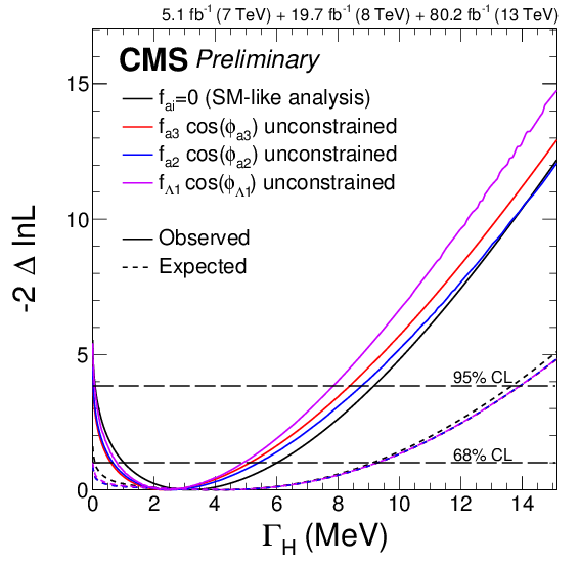
png pdf |
Figure 6-b:
Observed (solid) and expected (dashed) likelihood scans of ΓH. Results of analysis of the data from the combined Run 1 and Run 2 analyses for the SM-like couplings and with three anomalous coupling parameters of interest unconstrained: fa3cos(ϕa3) (red), fa2cos(ϕa2) (blue), and fΛ1cos(ϕΛ1) (violet). The dashed horizontal lines show the 68% and 95% CL regions. |
| Tables | |

png pdf |
Table 1:
List of anomalous HVV couplings considered in the measurements assuming a spin-zero H boson. The definition of the effective fractions is discussed in the text and the translation constant is given in each case. The effective cross sections correspond to the processes H→2e2μ and the Higgs boson mass mH= 125 GeV using the JHUGen [38,39,40] calculation. |
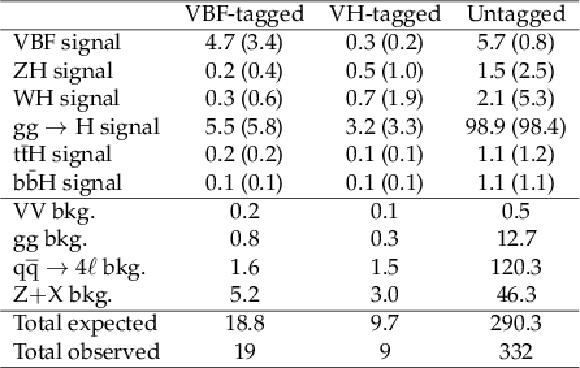
png pdf |
Table 2:
The numbers of events expected for the SM (or fa3= 1 in parentheses) for different signal and background modes and the total observed numbers of events across the three a3 analysis categories in the on-shell region. |

png pdf |
Table 3:
The numbers of events expected for the SM (or fa3=0 in the a3 analysis categorization in parentheses) for different signal and background modes and the total observed numbers of events across the three SM or a3 analysis categories in the off-shell region. For the gluon fusion (gg) and electroweak processes (VV), the combined yield from signal (s), background (b), and interference (i) is shown. |
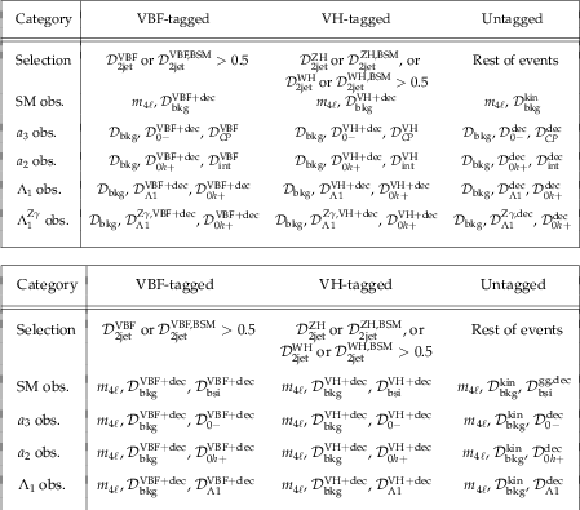
png pdf |
Table 4:
Summary of the three production categories in the on-shell m4ℓ region. Three or two observables (abbreviated as obs.) are listed for each analysis and for each category. All discriminants are calculated with JHUGen signal matrix elements and mcfm background matrix elements. The discriminants Dbkg in the tagged categories also include probabilities using associated jets and decay in addition to the m4ℓ probability. |

png pdf |
Table 5:
Summary of the three production categories in the off-shell m4ℓ region, listed in a similar manner to Table 4. All discriminants are calculated with JHUGen or MCFM/JHUGen signal, and MCFM background matrix elements. The VH interference discriminant in the SM analysis hadronic VH-tagged category is defined as the simple average of the ones corresponding to ZH and WH processes separately. |

png pdf |
Table 6:
Summary of allowed 68% CL (central values with uncertainties) and 95% CL (in square brackets) intervals on anomalous coupling parameters faicos(ϕai) obtained from the on-shell data analysis of the Run 1 and Run 2 combined dataset. |

png pdf |
Table 7:
Summary of allowed 68% CL (central values with uncertainties) and 95% CL (in square brackets) intervals on the anomalous coupling parameters faicos(ϕai) obtained from the data analysis of the Run 2 (on-shell and off-shell) and Run 1 (on-shell only) combined dataset. |

png pdf |
Table 8:
Summary of the total width ΓH measurement, showing allowed 68% CL (central values with uncertainties) and 95% CL (in square brackets). The limits are reported for the SM-like couplings using the Run 1 and Run 2 combination. |
| Summary |
| Studies of on-shell and off-shell Higgs boson production in the four-lepton final state are presented, using data from the CMS experiment at the LHC that corresponds to an integrated luminosity of 80.2 fb−1 at 13 TeV. Joint constraints are set on the width and parameters that express its anomalous couplings to two electroweak vector bosons using both on-shell and off-shell production of the Higgs boson. These results are combined with results from the data collected at center-of-mass energies of 7 and 8 TeV, corresponding to integrated luminosities of 5.1 and 19.7 fb−1, respectively. Matrix element techniques are utilized to combine kinematic information from the decay particles and the associated jets to identify the production mechanism and increase sensitivity to the anomalous couplings. The observations are found to be consistent with expectations for a Standard Model Higgs boson. |
| Additional Figures | |

png pdf |
Additional Figure 1:
Distributions of DCP in the on-shell fa3 analysis. Two tagging categories are shown: VBF-tagged (a) and VH-tagged (b). The decay or production information used in the discriminants depends on the tagging category. fVBFa3 and fVHa3 are defined by analogy with fa3, but using the cross sections for the VBF and VH processes, respectively. Points with error bars show data and histograms show expectations for background and SM or BSM signal as indicated in the legend. |

png pdf |
Additional Figure 1-a:
Distribution of DCP in the on-shell fa3 analysis for the VBF-tagged tagging category. The decay or production information used in the discriminant depends on the tagging category. fVBFa3 is defined by analogy with fa3, but using the cross section for the VBF process. Points with error bars show data and histograms show expectations for background and SM or BSM signal as indicated in the legend. |
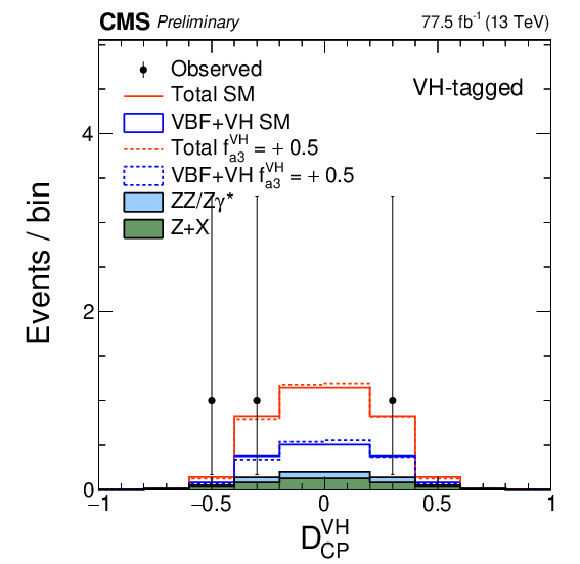
png pdf |
Additional Figure 1-b:
Distribution of DCP in the on-shell fa3 analysis for the VH-tagged tagging category. The decay or production information used in the discriminant depends on the tagging category. fVHa3 is defined by analogy with fa3, but using the cross section for the VH process. Points with error bars show data and histograms show expectations for background and SM or BSM signal as indicated in the legend. |

png pdf |
Additional Figure 2:
Distributions of kinematic discriminants in the on-shell fa2 analysis: Dbkg (a), (d), (g), D0h+ (b), (e), and Dint (c), (f), (h). Three tagging categories are shown: VBF-tagged (a)-(c), VH-tagged (d)-(f), and untagged (g), (h). The decay or production information used in the discriminants depends on the tagging category. fVBFa2 and fVHa2 are defined by analogy with fa2, but using the cross sections for the VBF and VH processes, respectively. Points with error bars show data and histograms show expectations for background and SM or BSM signal as indicated in the legend. |

png pdf |
Additional Figure 2-a:
Distributions of the Dbkg kinematic discriminant in the on-shell fa2 analysis, for the VBF-tagged category. The decay or production information used in the discriminant depends on the tagging category. Points with error bars show data and histograms show expectations for background and SM or BSM signal as indicated in the legend. |
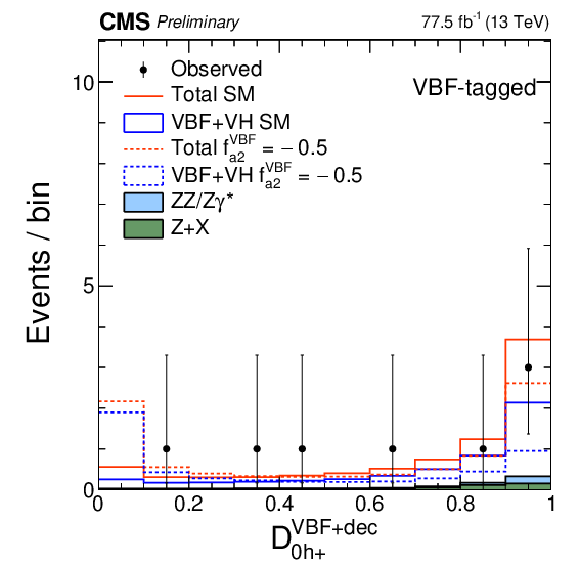
png pdf |
Additional Figure 2-b:
Distributions of the D0h+ kinematic discriminant in the on-shell fa2 analysis, for the VBF-tagged category. The decay or production information used in the discriminant depends on the tagging category. fVBFa2 is defined by analogy with fa2, but using the cross sections for the VBF process. Points with error bars show data and histograms show expectations for background and SM or BSM signal as indicated in the legend. |
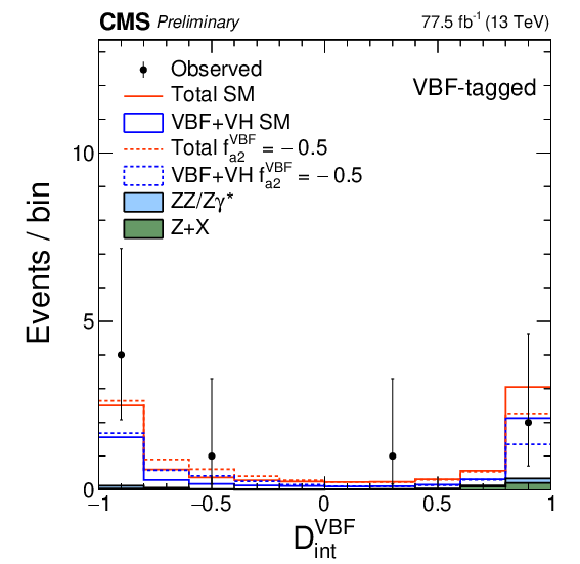
png pdf |
Additional Figure 2-c:
Distributions of the Dint kinematic discriminant in the on-shell fa2 analysis, for the VBF-tagged category. The decay or production information used in the discriminant depends on the tagging category. fVBFa2 is defined by analogy with fa2, but using the cross sections for the VBF process. Points with error bars show data and histograms show expectations for background and SM or BSM signal as indicated in the legend. |

png pdf |
Additional Figure 2-d:
Distributions of the Dbkg kinematic discriminant in the on-shell fa2 analysis, for the VH-tagged category. The decay or production information used in the discriminant depends on the tagging category. Points with error bars show data and histograms show expectations for background and SM or BSM signal as indicated in the legend. |

png pdf |
Additional Figure 2-e:
Distributions of the D0h+ kinematic discriminant in the on-shell fa2 analysis, for the VH-tagged category. The decay or production information used in the discriminant depends on the tagging category. fVHa2 is defined by analogy with fa2, but using the cross sections for the VH process. Points with error bars show data and histograms show expectations for background and SM or BSM signal as indicated in the legend. |

png pdf |
Additional Figure 2-f:
Distributions of the Dint kinematic discriminant in the on-shell fa2 analysis, for the VH-tagged category. The decay or production information used in the discriminant depends on the tagging category. fVHa2 is defined by analogy with fa2, but using the cross sections for the VH process. Points with error bars show data and histograms show expectations for background and SM or BSM signal as indicated in the legend. |
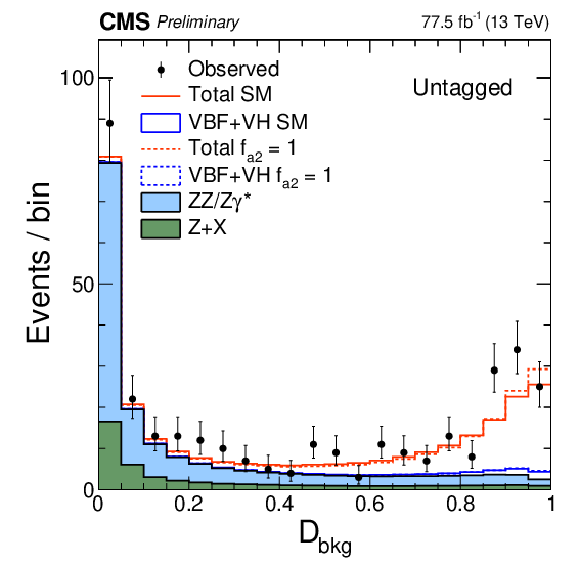
png pdf |
Additional Figure 2-g:
Distributions of the Dbkg kinematic discriminant in the on-shell fa2 analysis, for the untagged category. The decay or production information used in the discriminant depends on the tagging category. Points with error bars show data and histograms show expectations for background and SM or BSM signal as indicated in the legend. |

png pdf |
Additional Figure 2-h:
Distributions of the Dint kinematic discriminant in the on-shell fa2 analysis, for the untagged category. The decay or production information used in the discriminant depends on the tagging category. Points with error bars show data and histograms show expectations for background and SM or BSM signal as indicated in the legend. |

png pdf |
Additional Figure 3:
Distributions of kinematic discriminants in the on-shell fΛ1 analysis: Dbkg (a), (d), (g), DΛ1 (b), (e), and D0h+ (c), (f), (h). Three tagging categories are shown: VBF-tagged (a)-(c), VH-tagged (d)-(f), and untagged (g), (h). The decay or production information used in the discriminants depends on the tagging category. fVBFΛ1 and fVHΛ1 are defined by analogy with fΛ1, but using the cross sections for the VBF and VH processes, respectively. Points with error bars show data and histograms show expectations for background and SM or BSM signal as indicated in the legend. |
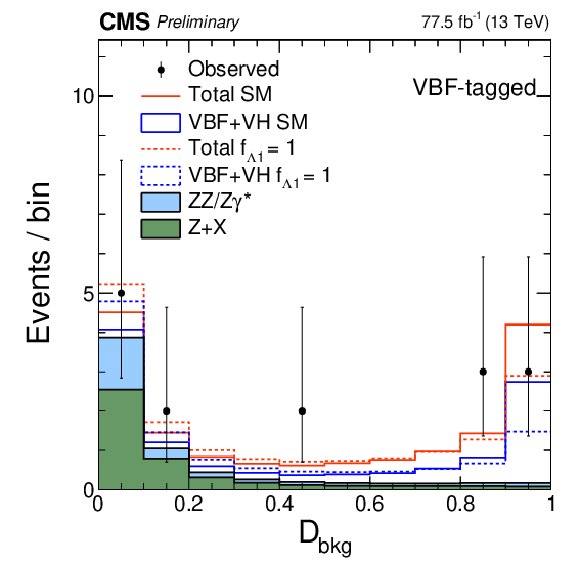
png pdf |
Additional Figure 3-a:
Distribution of the Dbkg kinematic discriminant in the on-shell fΛ1 analysis for the VBF-tagged category. The decay or production information used in the discriminants depends on the tagging category. Points with error bars show data and histograms show expectations for background and SM or BSM signal as indicated in the legend. |

png pdf |
Additional Figure 3-b:
Distribution of the DΛ1 kinematic discriminant in the on-shell fΛ1 analysis for the VBF-tagged category. The decay or production information used in the discriminants depends on the tagging category. fVBFΛ1 is defined by analogy with fΛ1, but using the cross sections for the VBF process. Points with error bars show data and histograms show expectations for background and SM or BSM signal as indicated in the legend. |

png pdf |
Additional Figure 3-c:
Distribution of the D0h+ kinematic discriminant in the on-shell fΛ1 analysis for the VBF-tagged category. The decay or production information used in the discriminants depends on the tagging category. fVBFΛ1 is defined by analogy with fΛ1, but using the cross sections for the VBF process. Points with error bars show data and histograms show expectations for background and SM or BSM signal as indicated in the legend. |

png pdf |
Additional Figure 3-d:
Distribution of the Dbkg kinematic discriminant in the on-shell fΛ1 analysis for the VH-tagged category. The decay or production information used in the discriminants depends on the tagging category. Points with error bars show data and histograms show expectations for background and SM or BSM signal as indicated in the legend. |
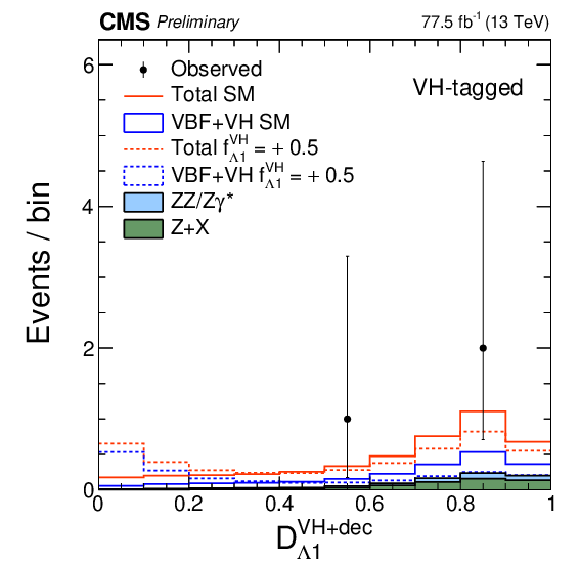
png pdf |
Additional Figure 3-e:
Distribution of the DΛ1 kinematic discriminant in the on-shell fΛ1 analysis for the VH-tagged category. The decay or production information used in the discriminants depends on the tagging category. fVHΛ1 is defined by analogy with fΛ1, but using the cross sections for the VH process. Points with error bars show data and histograms show expectations for background and SM or BSM signal as indicated in the legend. |
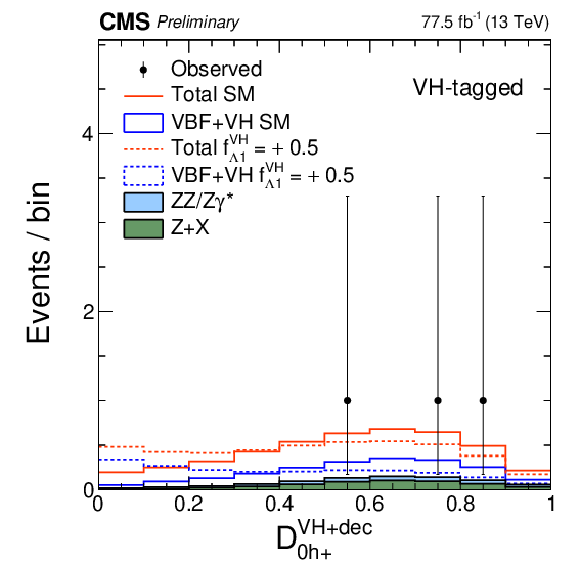
png pdf |
Additional Figure 3-f:
Distribution of the D0h+ kinematic discriminant in the on-shell fΛ1 analysis for the VH-tagged category. The decay or production information used in the discriminants depends on the tagging category. fVHΛ1 is defined by analogy with fΛ1, but using the cross sections for the VH process. Points with error bars show data and histograms show expectations for background and SM or BSM signal as indicated in the legend. |
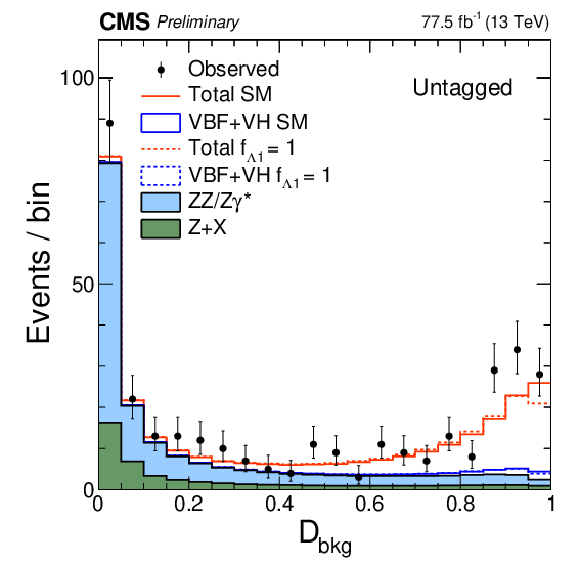
png pdf |
Additional Figure 3-g:
Distribution of the Dbkg kinematic discriminant in the on-shell fΛ1 analysis for the untagged category. The decay or production information used in the discriminants depends on the tagging category. Points with error bars show data and histograms show expectations for background and SM or BSM signal as indicated in the legend. |

png pdf |
Additional Figure 3-h:
Distribution of the D0h+ kinematic discriminant in the on-shell fΛ1 analysis for the untagged category. The decay or production information used in the discriminants depends on the tagging category. Points with error bars show data and histograms show expectations for background and SM or BSM signal as indicated in the legend. |

png pdf |
Additional Figure 4:
Distributions of kinematic discriminants in the on-shell fZγΛ1 analysis: Dbkg (a), (d), (g), DZγΛ1 (b), (e), and D0h+ (c), (f), (h). Three tagging categories are shown: VBF-tagged (a)-(c), VH-tagged (d)-(f), and untagged (g), (h). The decay or production information used in the discriminants depends on the tagging category. Points with error bars show data and histograms show expectations for background and SM or BSM signal as indicated in the legend. |

png pdf |
Additional Figure 4-a:
Distribution of the Dbkg kinematic discriminant in the on-shell fZγΛ1 analysis for the VBF-tagged category. The decay or production information used in the discriminant depends on the tagging category. Points with error bars show data and histograms show expectations for background and SM or BSM signal as indicated in the legend. |

png pdf |
Additional Figure 4-b:
Distribution of the DZγΛ1 kinematic discriminant in the on-shell fZγΛ1 analysis for the VBF-tagged category. The decay or production information used in the discriminant depends on the tagging category. Points with error bars show data and histograms show expectations for background and SM or BSM signal as indicated in the legend. |
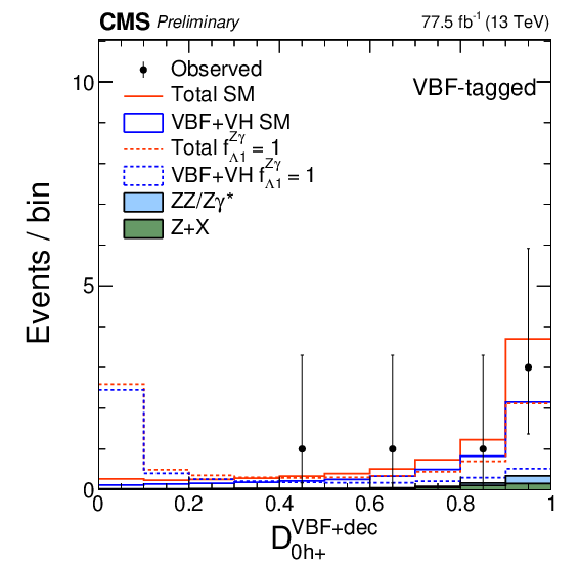
png pdf |
Additional Figure 4-c:
Distribution of the D0h+ kinematic discriminant in the on-shell fZγΛ1 analysis for the VBF-tagged category. The decay or production information used in the discriminant depends on the tagging category. Points with error bars show data and histograms show expectations for background and SM or BSM signal as indicated in the legend. |
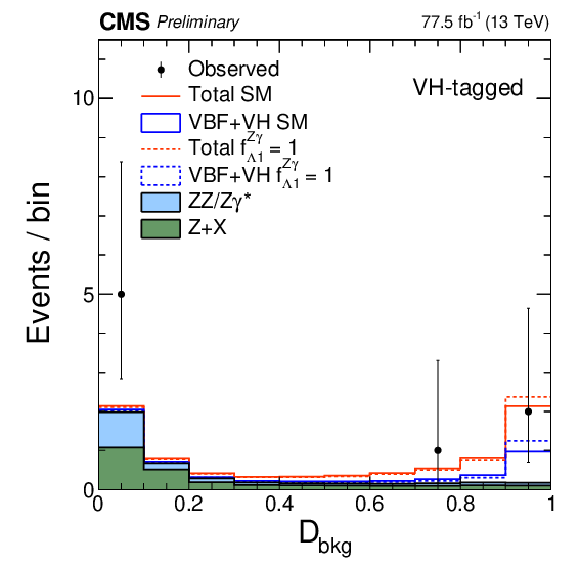
png pdf |
Additional Figure 4-d:
Distribution of the Dbkg kinematic discriminant in the on-shell fZγΛ1 analysis for the VH-tagged category. The decay or production information used in the discriminant depends on the tagging category. Points with error bars show data and histograms show expectations for background and SM or BSM signal as indicated in the legend. |

png pdf |
Additional Figure 4-e:
Distribution of the DZγΛ1 kinematic discriminant in the on-shell fZγΛ1 analysis for the VH-tagged category. The decay or production information used in the discriminant depends on the tagging category. Points with error bars show data and histograms show expectations for background and SM or BSM signal as indicated in the legend. |
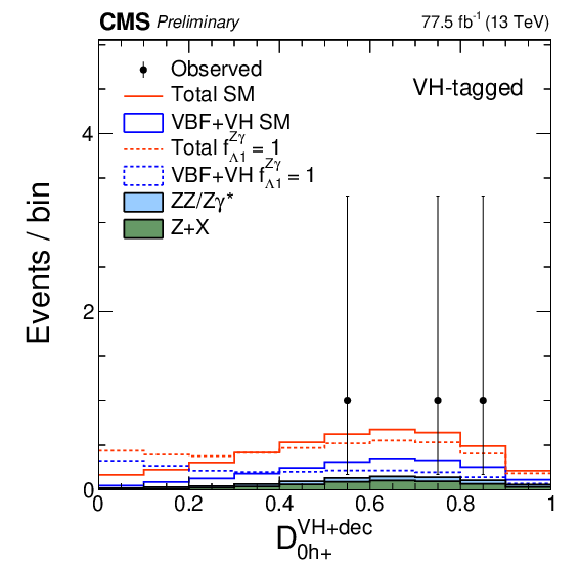
png pdf |
Additional Figure 4-f:
Distribution of the D0h+ kinematic discriminant in the on-shell fZγΛ1 analysis for the VH-tagged category. The decay or production information used in the discriminant depends on the tagging category. Points with error bars show data and histograms show expectations for background and SM or BSM signal as indicated in the legend. |

png pdf |
Additional Figure 4-g:
Distribution of the Dbkg kinematic discriminant in the on-shell fZγΛ1 analysis for the untagged category. The decay or production information used in the discriminant depends on the tagging category. Points with error bars show data and histograms show expectations for background and SM or BSM signal as indicated in the legend. |
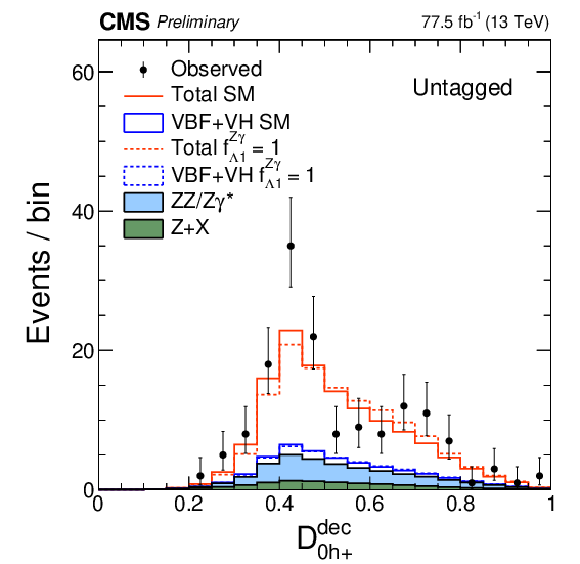
png pdf |
Additional Figure 4-h:
Distribution of the D0h+ kinematic discriminant in the on-shell fZγΛ1 analysis for the untagged category. The decay or production information used in the discriminant depends on the tagging category. Points with error bars show data and histograms show expectations for background and SM or BSM signal as indicated in the legend. |

png pdf |
Additional Figure 5:
Distributions of Dbkg kinematic discriminants in the off-shell SM-like width analysis. Three tagging categories are shown: VBF-tagged (a), VH-tagged (b), and untagged (c). The decay or production information used in the discriminants depends on the tagging category. The requirement m4ℓ> 340 GeV is applied in order to enhance signal over background contributions. Points with error bars show data and histograms show expectations for background and SM or BSM signal as indicated in the legend. |

png pdf |
Additional Figure 5-a:
Distribution of Dbkg kinematic discriminant in the off-shell SM-like width analysis for the VBF-tagged category. The decay or production information used in the discriminant depends on the tagging category. The requirement m4ℓ> 340 GeV is applied in order to enhance signal over background contributions. Points with error bars show data and histograms show expectations for background and SM or BSM signal as indicated in the legend. |

png pdf |
Additional Figure 5-b:
Distribution of Dbkg kinematic discriminant in the off-shell SM-like width analysis for the VH-tagged category. The decay or production information used in the discriminant depends on the tagging category. The requirement m4ℓ> 340 GeV is applied in order to enhance signal over background contributions. Points with error bars show data and histograms show expectations for background and SM or BSM signal as indicated in the legend. |
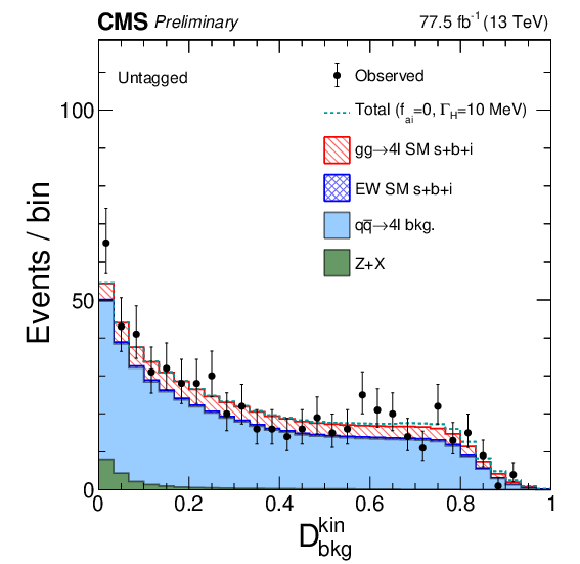
png pdf |
Additional Figure 5-c:
Distribution of Dbkg kinematic discriminant in the off-shell SM-like width analysis for the untagged category. The decay or production information used in the discriminant depends on the tagging category. The requirement m4ℓ> 340 GeV is applied in order to enhance signal over background contributions. Points with error bars show data and histograms show expectations for background and SM or BSM signal as indicated in the legend. |
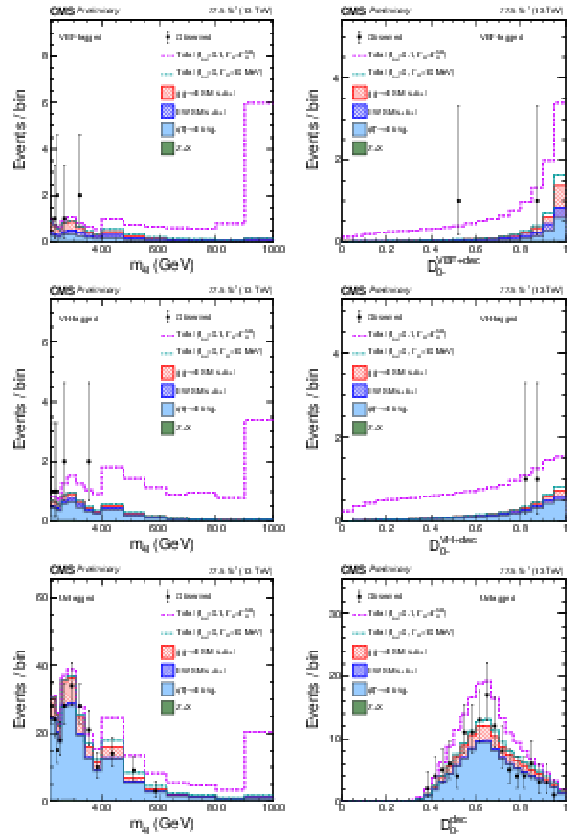
png pdf |
Additional Figure 6:
Distributions of kinematic discriminants in the off-shell fa3 analysis: m4ℓ (a), (c), (e), and D0− (b), (d), (f). Three tagging categories are shown: VBF-tagged (a), (b), VH-tagged (c), (d), and untagged (e), (f). The decay or production information used in the discriminants depends on the tagging category. The requirement m4ℓ> 340 GeV is applied in order to enhance signal over background contributions. Points with error bars show data and histograms show expectations for background and SM or BSM signal as indicated in the legend. |

png pdf |
Additional Figure 6-a:
Distribution of the m4ℓ kinematic discriminant in the off-shell fa3 analysis for the VBF-tagged category. The decay or production information used in the discriminant depends on the tagging category. The requirement m4ℓ> 340 GeV is applied in order to enhance signal over background contributions. Points with error bars show data and histograms show expectations for background and SM or BSM signal as indicated in the legend. |
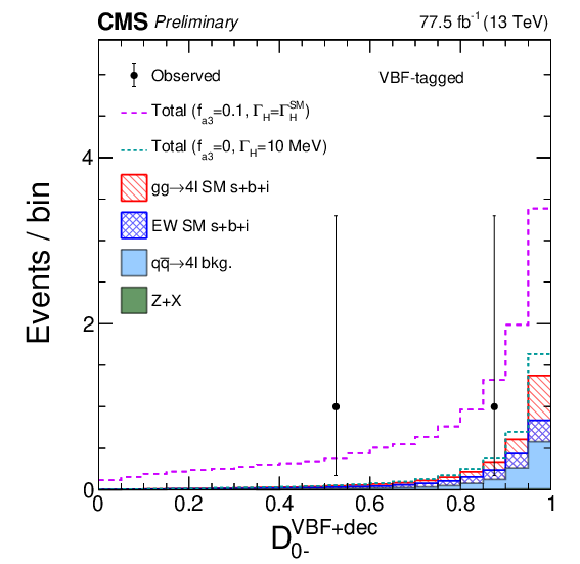
png pdf |
Additional Figure 6-b:
Distribution of the D0− kinematic discriminant in the off-shell fa3 analysis for the VBF-tagged category. The decay or production information used in the discriminant depends on the tagging category. The requirement m4ℓ> 340 GeV is applied in order to enhance signal over background contributions. Points with error bars show data and histograms show expectations for background and SM or BSM signal as indicated in the legend. |

png pdf |
Additional Figure 6-c:
Distribution of the m4ℓ kinematic discriminant in the off-shell fa3 analysis for the VH-tagged category. The decay or production information used in the discriminant depends on the tagging category. The requirement m4ℓ> 340 GeV is applied in order to enhance signal over background contributions. Points with error bars show data and histograms show expectations for background and SM or BSM signal as indicated in the legend. |
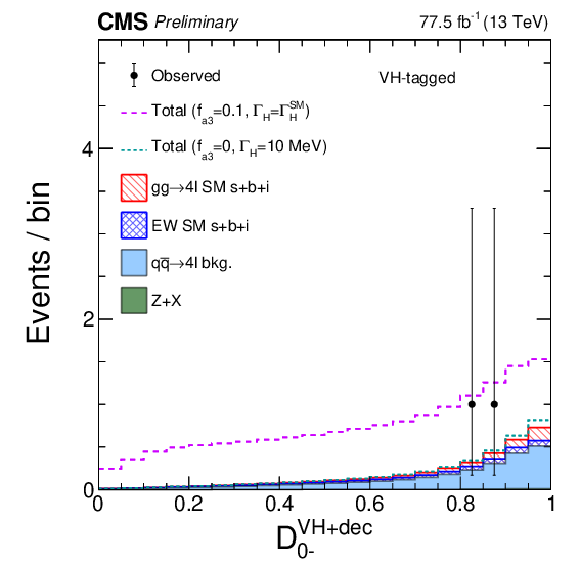
png pdf |
Additional Figure 6-d:
Distribution of the D0− kinematic discriminant in the off-shell fa3 analysis for the VH-tagged category. The decay or production information used in the discriminant depends on the tagging category. The requirement m4ℓ> 340 GeV is applied in order to enhance signal over background contributions. Points with error bars show data and histograms show expectations for background and SM or BSM signal as indicated in the legend. |
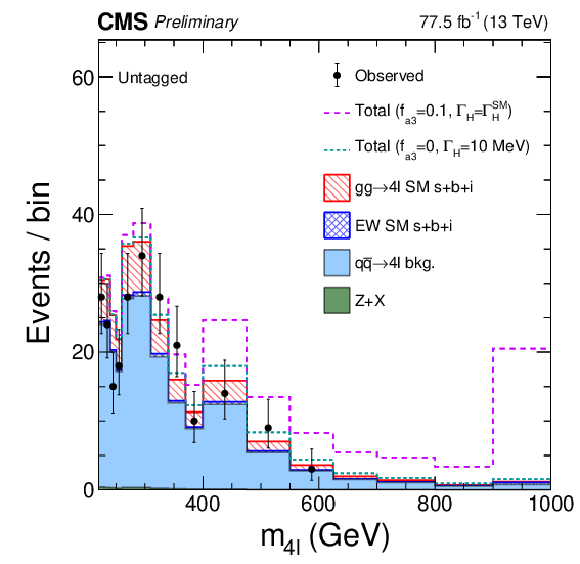
png pdf |
Additional Figure 6-e:
Distribution of the m4ℓ kinematic discriminant in the off-shell fa3 analysis for the untagged category. The decay or production information used in the discriminant depends on the tagging category. The requirement m4ℓ> 340 GeV is applied in order to enhance signal over background contributions. Points with error bars show data and histograms show expectations for background and SM or BSM signal as indicated in the legend. |

png pdf |
Additional Figure 6-f:
Distribution of the D0− kinematic discriminant in the off-shell fa3 analysis for the untagged category. The decay or production information used in the discriminant depends on the tagging category. The requirement m4ℓ> 340 GeV is applied in order to enhance signal over background contributions. Points with error bars show data and histograms show expectations for background and SM or BSM signal as indicated in the legend. |
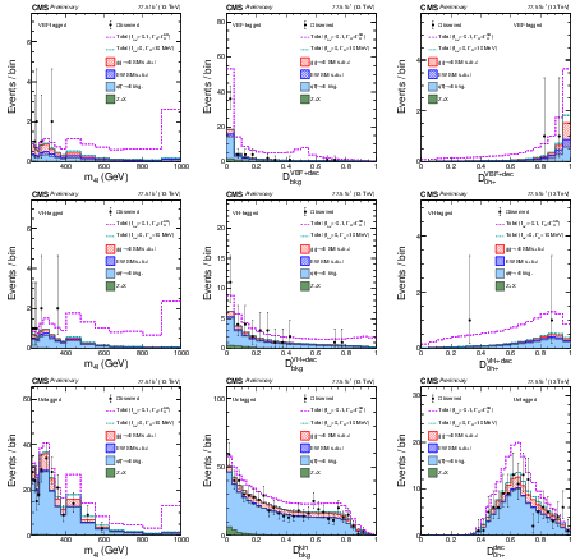
png pdf |
Additional Figure 7:
Distributions of kinematic discriminants in the off-shell fa2 analysis: m4ℓ (a), (d), (g), Dbkg (b), (e), (h), and D0h+ (c), (f), (i). Three tagging categories are shown: VBF-tagged (a)-(c), VH-tagged (d)-(f), and untagged (g)-(h). The decay or production information used in the discriminants depends on the tagging category. The requirement m4ℓ> 340 GeV is applied in order to enhance signal over background contributions. Points with error bars show data and histograms show expectations for background and SM or BSM signal as indicated in the legend. |
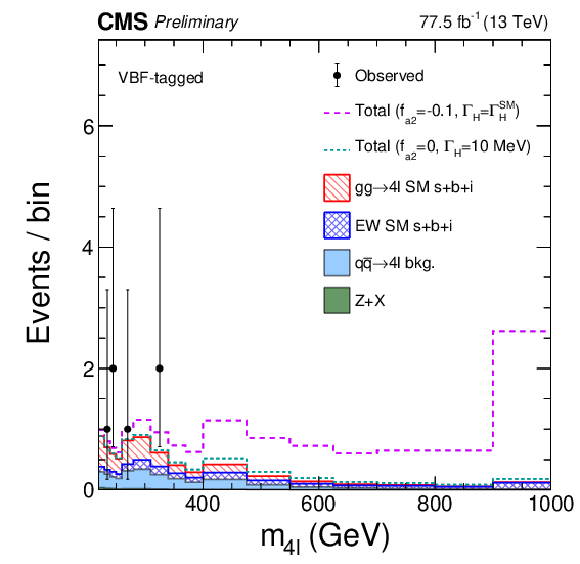
png pdf |
Additional Figure 7-a:
Distribution of the m4ℓ kinematic discriminant in the off-shell fa2 analysis in the VBF-tagged category. The decay or production information used in the discriminant depends on the tagging category. The requirement m4ℓ> 340 GeV is applied in order to enhance signal over background contributions. Points with error bars show data and histograms show expectations for background and SM or BSM signal as indicated in the legend. |

png pdf |
Additional Figure 7-b:
Distribution of the Dbkg kinematic discriminant in the off-shell fa2 analysis in the VBF-tagged category. The decay or production information used in the discriminant depends on the tagging category. The requirement m4ℓ> 340 GeV is applied in order to enhance signal over background contributions. Points with error bars show data and histograms show expectations for background and SM or BSM signal as indicated in the legend. |
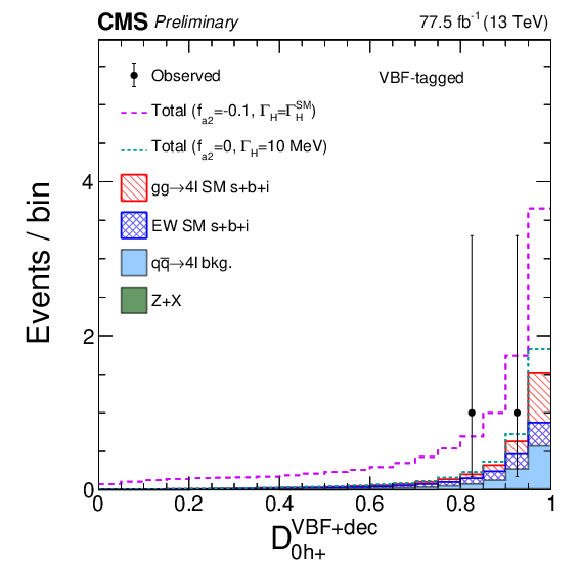
png pdf |
Additional Figure 7-c:
Distribution of the D0h+ kinematic discriminant in the off-shell fa2 analysis in the VBF-tagged category. The decay or production information used in the discriminant depends on the tagging category. The requirement m4ℓ> 340 GeV is applied in order to enhance signal over background contributions. Points with error bars show data and histograms show expectations for background and SM or BSM signal as indicated in the legend. |

png pdf |
Additional Figure 7-d:
Distribution of the m4ℓ kinematic discriminant in the off-shell fa2 analysis in the VH-tagged category. The decay or production information used in the discriminant depends on the tagging category. The requirement m4ℓ> 340 GeV is applied in order to enhance signal over background contributions. Points with error bars show data and histograms show expectations for background and SM or BSM signal as indicated in the legend. |

png pdf |
Additional Figure 7-e:
Distribution of the Dbkg kinematic discriminant in the off-shell fa2 analysis in the VH-tagged category. The decay or production information used in the discriminant depends on the tagging category. The requirement m4ℓ> 340 GeV is applied in order to enhance signal over background contributions. Points with error bars show data and histograms show expectations for background and SM or BSM signal as indicated in the legend. |

png pdf |
Additional Figure 7-f:
Distribution of the D0h+ kinematic discriminant in the off-shell fa2 analysis in the VH-tagged category. The decay or production information used in the discriminant depends on the tagging category. The requirement m4ℓ> 340 GeV is applied in order to enhance signal over background contributions. Points with error bars show data and histograms show expectations for background and SM or BSM signal as indicated in the legend. |

png pdf |
Additional Figure 7-g:
Distribution of the m4ℓ kinematic discriminant in the off-shell fa2 analysis in the untagged category. The decay or production information used in the discriminant depends on the tagging category. The requirement m4ℓ> 340 GeV is applied in order to enhance signal over background contributions. Points with error bars show data and histograms show expectations for background and SM or BSM signal as indicated in the legend. |

png pdf |
Additional Figure 7-h:
Distribution of the Dbkg kinematic discriminant in the off-shell fa2 analysis in the untagged category. The decay or production information used in the discriminant depends on the tagging category. The requirement m4ℓ> 340 GeV is applied in order to enhance signal over background contributions. Points with error bars show data and histograms show expectations for background and SM or BSM signal as indicated in the legend. |

png pdf |
Additional Figure 7-i:
Distribution of the D0h+ kinematic discriminant in the off-shell fa2 analysis in the untagged category. The decay or production information used in the discriminant depends on the tagging category. The requirement m4ℓ> 340 GeV is applied in order to enhance signal over background contributions. Points with error bars show data and histograms show expectations for background and SM or BSM signal as indicated in the legend. |
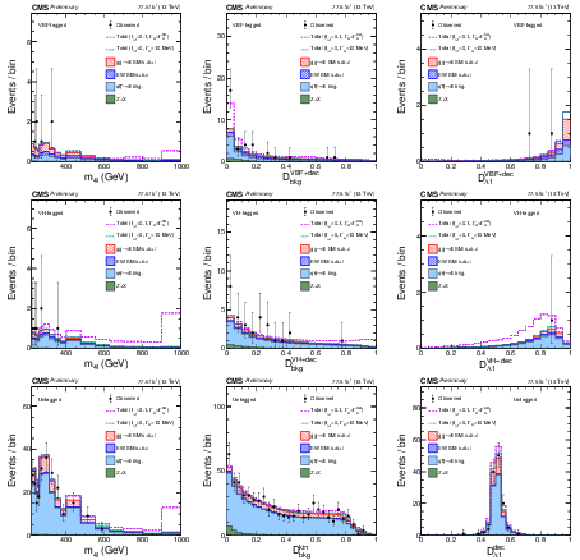
png pdf |
Additional Figure 8:
Distributions of kinematic discriminants in the off-shell fΛ1 analysis: m4ℓ (a), (d), (g), Dbkg (b), (e), (h), and DΛ1 (c), (f), (i). Three tagging categories are shown: VBF-tagged (a)-(c), VH-tagged (d)-(f), and untagged (g)-(h). The decay or production information used in the discriminants depends on the tagging category. The requirement m4ℓ> 340 GeV is applied in order to enhance signal over background contributions. Points with error bars show data and histograms show expectations for background and SM or BSM signal as indicated in the legend. |
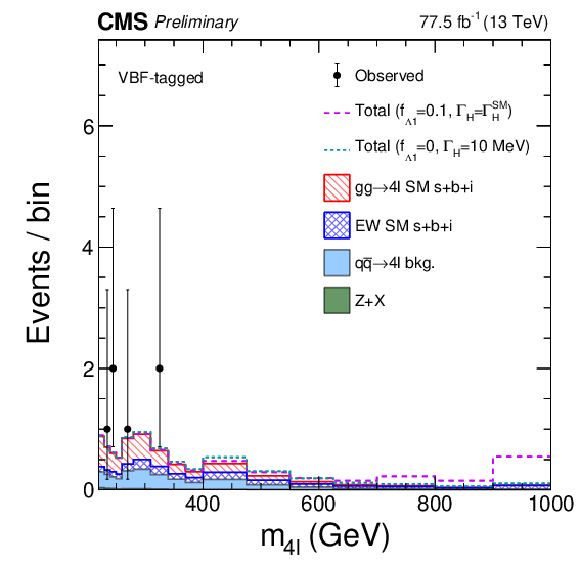
png pdf |
Additional Figure 8-a:
Distribution of the m4ℓ kinematic discriminant in the off-shell fΛ1 analysis for the VBF-tagged category. The decay or production information used in the discriminant depends on the tagging category. The requirement m4ℓ> 340 GeV is applied in order to enhance signal over background contributions. Points with error bars show data and histograms show expectations for background and SM or BSM signal as indicated in the legend. |

png pdf |
Additional Figure 8-b:
Distribution of the Dbkg kinematic discriminant in the off-shell fΛ1 analysis for the VBF-tagged category. The decay or production information used in the discriminant depends on the tagging category. The requirement m4ℓ> 340 GeV is applied in order to enhance signal over background contributions. Points with error bars show data and histograms show expectations for background and SM or BSM signal as indicated in the legend. |
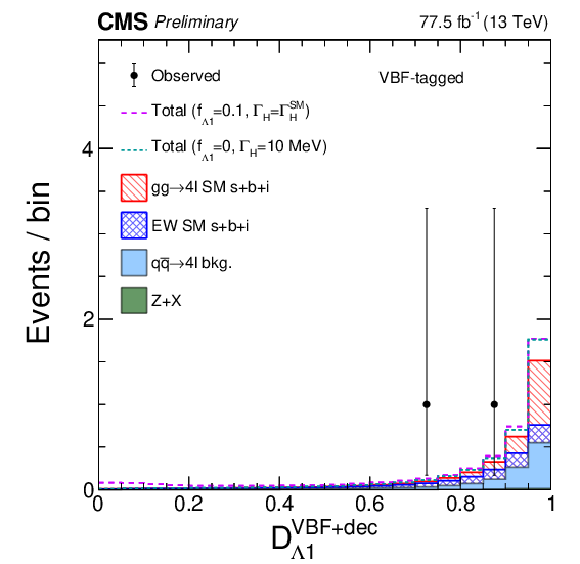
png pdf |
Additional Figure 8-c:
Distribution of the DΛ1 kinematic discriminant in the off-shell fΛ1 analysis for the VBF-tagged category. The decay or production information used in the discriminant depends on the tagging category. The requirement m4ℓ> 340 GeV is applied in order to enhance signal over background contributions. Points with error bars show data and histograms show expectations for background and SM or BSM signal as indicated in the legend. |

png pdf |
Additional Figure 8-d:
Distribution of the m4ℓ kinematic discriminant in the off-shell fΛ1 analysis for the VH-tagged category. The decay or production information used in the discriminant depends on the tagging category. The requirement m4ℓ> 340 GeV is applied in order to enhance signal over background contributions. Points with error bars show data and histograms show expectations for background and SM or BSM signal as indicated in the legend. |
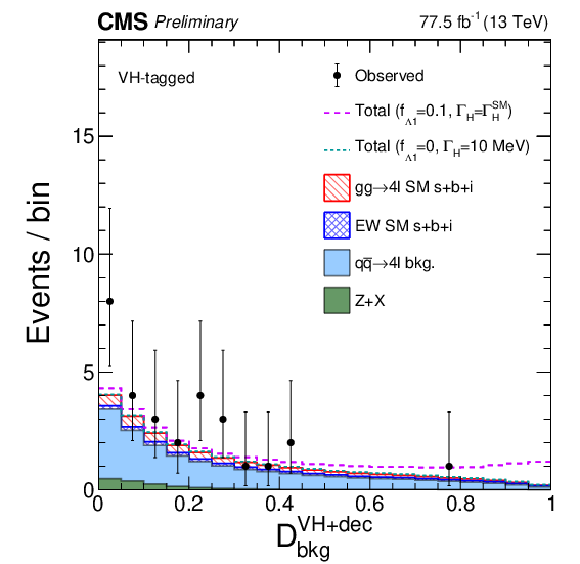
png pdf |
Additional Figure 8-e:
Distribution of the Dbkg kinematic discriminant in the off-shell fΛ1 analysis for the VH-tagged category. The decay or production information used in the discriminant depends on the tagging category. The requirement m4ℓ> 340 GeV is applied in order to enhance signal over background contributions. Points with error bars show data and histograms show expectations for background and SM or BSM signal as indicated in the legend. |

png pdf |
Additional Figure 8-f:
Distribution of the DΛ1 kinematic discriminant in the off-shell fΛ1 analysis for the VH-tagged category. The decay or production information used in the discriminant depends on the tagging category. The requirement m4ℓ> 340 GeV is applied in order to enhance signal over background contributions. Points with error bars show data and histograms show expectations for background and SM or BSM signal as indicated in the legend. |

png pdf |
Additional Figure 8-g:
Distribution of the m4ℓ kinematic discriminant in the off-shell fΛ1 analysis for the untagged category. The decay or production information used in the discriminant depends on the tagging category. The requirement m4ℓ> 340 GeV is applied in order to enhance signal over background contributions. Points with error bars show data and histograms show expectations for background and SM or BSM signal as indicated in the legend. |
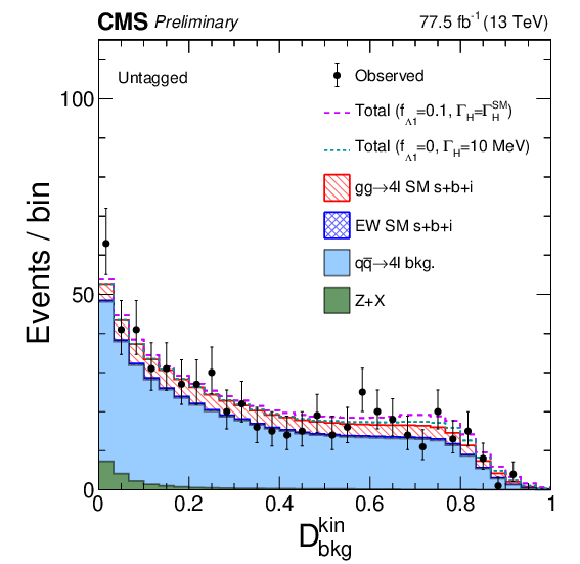
png pdf |
Additional Figure 8-h:
Distribution of the Dbkg kinematic discriminant in the off-shell fΛ1 analysis for the untagged category. The decay or production information used in the discriminant depends on the tagging category. The requirement m4ℓ> 340 GeV is applied in order to enhance signal over background contributions. Points with error bars show data and histograms show expectations for background and SM or BSM signal as indicated in the legend. |

png pdf |
Additional Figure 8-i:
Distribution of the DΛ1 kinematic discriminant in the off-shell fΛ1 analysis for the untagged category. The decay or production information used in the discriminant depends on the tagging category. The requirement m4ℓ> 340 GeV is applied in order to enhance signal over background contributions. Points with error bars show data and histograms show expectations for background and SM or BSM signal as indicated in the legend. |

png pdf |
Additional Figure 9:
Summary of allowed confidence level intervals on anomalous coupling parameters in HVV interactions under the assumption that all the coupling ratios are real (ϕVVai=0 or π). The HZZ+HWW coupling limits assume that aZZi=aWWi. The expected 68% and 95% CL regions are shown as green and yellow bands, and the observed regions are shown as points with errors and the excluded hatched regions. The limits on fZγ,γγa2,3 are from Ref. [25], and the limits on fΛQ are from Ref. [13]. |
| References | ||||
| 1 | S. L. Glashow | Partial-symmetries of Weak Interactions | NP 22 (1961) 579 | |
| 2 | F. Englert and R. Brout | Broken Symmetry and the Mass of Gauge Vector Mesons | PRL 13 (1964) 321 | |
| 3 | P. W. Higgs | Broken symmetries, massless particles and gauge fields | PL12 (1964) 132 | |
| 4 | P. W. Higgs | Broken Symmetries and the Masses of Gauge Bosons | PRL 13 (1964) 508 | |
| 5 | G. S. Guralnik, C. R. Hagen, and T. W. B. Kibble | Global Conservation Laws and Massless Particles | PRL 13 (1964) 585 | |
| 6 | S. Weinberg | A Model of Leptons | PRL 19 (1967) 1264 | |
| 7 | A. Salam | Weak and electromagnetic interactions | in Elementary particle physics: relativistic groups and analyticity, N. Svartholm, ed., p. 367 Almqvist \& Wiksell, Stockholm, 1968 Proceedings of the eighth Nobel symposium | |
| 8 | ATLAS Collaboration | Observation of a new particle in the search for the Standard Model Higgs boson with the ATLAS detector at the LHC | PLB 716 (2012) 1 | 1207.7214 |
| 9 | CMS Collaboration | Observation of a new boson at a mass of 125 GeV with the CMS experiment at the LHC | PLB716 (2012) 30--61 | CMS-HIG-12-028 1207.7235 |
| 10 | CMS Collaboration | Observation of a new boson with mass near 125 GeV in pp collisions at √s= 7 and 8 TeV | JHEP 06 (2013) 081 | CMS-HIG-12-036 1303.4571 |
| 11 | CMS Collaboration | Constraints on the Higgs boson width from off-shell production and decay to Z-boson pairs | PLB736 (2014) 64--85 | CMS-HIG-14-002 1405.3455 |
| 12 | ATLAS Collaboration | Constraints on the off-shell Higgs boson signal strength in the high-mass ZZ and WW final states with the ATLAS detector | EPJC75 (2015), no. 7, 335 | 1503.01060 |
| 13 | CMS Collaboration | Limits on the Higgs boson lifetime and width from its decay to four charged leptons | PRD92 (2015), no. 7, 072010 | CMS-HIG-14-036 1507.06656 |
| 14 | CMS Collaboration | Search for Higgs boson off-shell production in proton-proton collisions at 7 and 8 TeV and derivation of constraints on its total decay width | JHEP 09 (2016) 051 | CMS-HIG-14-032 1605.02329 |
| 15 | ATLAS Collaboration | Constraints on off-shell Higgs boson production and the Higgs boson total width in ZZ→4ℓ and ZZ→2ℓ2ν final states with the ATLAS detector | 1808.01191 | |
| 16 | F. Caola and K. Melnikov | Constraining the Higgs boson width with ZZ production at the LHC | PRD88 (2013) 054024 | 1307.4935 |
| 17 | N. Kauer and G. Passarino | Inadequacy of zero-width approximation for a light Higgs boson signal | JHEP 08 (2012) 116 | 1206.4803 |
| 18 | J. M. Campbell, R. K. Ellis, and C. Williams | Bounding the Higgs width at the LHC using full analytic results for gg→e−e+μ−μ+ | JHEP 04 (2014) 060 | 1311.3589 |
| 19 | CMS Collaboration | Precise determination of the mass of the Higgs boson and tests of compatibility of its couplings with the standard model predictions using proton collisions at 7 and 8 TeV | EPJC75 (2015), no. 5, 212 | CMS-HIG-14-009 1412.8662 |
| 20 | ATLAS Collaboration | Measurement of the Higgs boson mass from the H→γγ and H→ZZ∗→4ℓ channels with the ATLAS detector using 25 fb−1 of pp collision data | PRD 90 (2014) 052004 | 1406.3827 |
| 21 | CMS Collaboration | Measurements of properties of the Higgs boson decaying into the four-lepton final state in pp collisions at √s= 13 TeV | JHEP 11 (2017) 047 | CMS-HIG-16-041 1706.09936 |
| 22 | LHC Higgs Cross Section Working Group Collaboration | Handbook of LHC Higgs Cross Sections: 4. Deciphering the Nature of the Higgs Sector | 1610.07922 | |
| 23 | CMS Collaboration | On the mass and spin-parity of the Higgs boson candidate via its decays to Z boson pairs | PRL 110 (2013) 081803 | CMS-HIG-12-041 1212.6639 |
| 24 | CMS Collaboration | Measurement of the properties of a Higgs boson in the four-lepton final state | PRD 89 (2014) 092007 | CMS-HIG-13-002 1312.5353 |
| 25 | CMS Collaboration | Constraints on the spin-parity and anomalous HVV couplings of the Higgs boson in proton collisions at 7 and 8 TeV | PRD92 (2015), no. 1, 012004 | CMS-HIG-14-018 1411.3441 |
| 26 | CMS Collaboration | Combined search for anomalous pseudoscalar HVV couplings in VH(H →bˉb) production and H → VV decay | PLB759 (2016) 672--696 | CMS-HIG-14-035 1602.04305 |
| 27 | CMS Collaboration | Constraints on anomalous Higgs boson couplings using production and decay information in the four-lepton final state | PLB775 (2017) 1--24 | CMS-HIG-17-011 1707.00541 |
| 28 | ATLAS Collaboration | Evidence for the spin-0 nature of the Higgs boson using ATLAS data | PLB 726 (2013) 120 | 1307.1432 |
| 29 | ATLAS Collaboration | Study of the spin and parity of the Higgs boson in diboson decays with the ATLAS detector | EPJC75 (2015), no. 10, 476 | 1506.05669 |
| 30 | ATLAS Collaboration | Test of CP Invariance in vector-boson fusion production of the Higgs boson using the Optimal Observable method in the ditau decay channel with the ATLAS detector | EPJC76 (2016), no. 12, 658 | 1602.04516 |
| 31 | J. S. Gainer et al. | Beyond Geolocating: Constraining Higher Dimensional Operators in H→4ℓ with Off-Shell Production and More | PRD91 (2015), no. 3, 035011 | 1403.4951 |
| 32 | C. Englert and M. Spannowsky | Limitations and opportunities of off-shell coupling measurements | PRD 90 (2014) 053003 | 1405.0285 |
| 33 | M. Ghezzi, G. Passarino, and S. Uccirati | Bounding the Higgs Width Using Effective Field Theory | PoS LL2014 (2014) 072 | 1405.1925 |
| 34 | CMS Collaboration Collaboration | Measurements of properties of the Higgs boson in the four-lepton final state at √s= 13 TeV | CMS-PAS-HIG-18-001, CERN, Geneva | |
| 35 | CMS Collaboration | Search for a new scalar resonance decaying to a pair of Z bosons in proton-proton collisions at √s= 13 TeV | JHEP 06 (2018) 127 | CMS-HIG-17-012 1804.01939 |
| 36 | M. Gonzalez-Alonso, A. Greljo, G. Isidori, and D. Marzocca | Pseudo-observables in Higgs decays | EPJC75 (2015) 128 | 1412.6038 |
| 37 | A. Greljo, G. Isidori, J. M. Lindert, and D. Marzocca | Pseudo-observables in electroweak Higgs production | EPJC76 (2016), no. 3, 158 | 1512.06135 |
| 38 | Y. Gao et al. | Spin determination of single-produced resonances at hadron colliders | PRD 81 (2010) 075022 | 1001.3396 |
| 39 | S. Bolognesi et al. | Spin and parity of a single-produced resonance at the LHC | PRD 86 (2012) 095031 | 1208.4018 |
| 40 | I. Anderson et al. | Constraining anomalous HVV interactions at proton and lepton colliders | PRD 89 (2014) 035007 | 1309.4819 |
| 41 | CMS Collaboration | The CMS experiment at the CERN LHC | JINST 3 (2008) S08004 | CMS-00-001 |
| 42 | CMS Collaboration | CMS Luminosity Measurements for the 2016 Data Taking Period | CMS-PAS-LUM-17-001 | CMS-PAS-LUM-17-001 |
| 43 | A. V. Gritsan, R. Roentsch, M. Schulze, and M. Xiao | Constraining anomalous Higgs boson couplings to the heavy flavor fermions using matrix element techniques | PRD94 (2016), no. 5, 055023 | 1606.03107 |
| 44 | S. Frixione, P. Nason, and C. Oleari | Matching NLO QCD computations with Parton Shower simulations: the POWHEG method | JHEP 11 (2007) 070 | 0709.2092 |
| 45 | E. Bagnaschi, G. Degrassi, P. Slavich, and A. Vicini | Higgs production via gluon fusion in the POWHEG approach in the SM and in the MSSM | JHEP 02 (2012) 088 | 1111.2854 |
| 46 | P. Nason and C. Oleari | NLO Higgs boson production via vector-boson fusion matched with shower in POWHEG | JHEP 02 (2010) 037 | 0911.5299 |
| 47 | G. Luisoni, P. Nason, C. Oleari, and F. Tramontano | HW±/HZ + 0 and 1 jet at NLO with the POWHEG BOX interfaced to GoSam and their merging within MiNLO | JHEP 10 (2013) 083 | 1306.2542 |
| 48 | H. B. Hartanto, B. Jager, L. Reina, and D. Wackeroth | Higgs boson production in association with top quarks in the POWHEG BOX | PRD91 (2015), no. 9, 094003 | 1501.04498 |
| 49 | K. Hamilton, P. Nason, and G. Zanderighi | MINLO: Multi-Scale Improved NLO | JHEP 10 (2012) 155 | 1206.3572 |
| 50 | J. M. Campbell and R. K. Ellis | MCFM for the Tevatron and the LHC | NPPS 205 (2010) 10 | 1007.3492 |
| 51 | J. M. Campbell, R. K. Ellis, and C. Williams | Vector boson pair production at the LHC | JHEP 07 (2011) 018 | 1105.0020 |
| 52 | J. M. Campbell and R. K. Ellis | Higgs Constraints from Vector Boson Fusion and Scattering | JHEP 04 (2015) 030 | 1502.02990 |
| 53 | A. Ballestrero et al. | PHANTOM: a Monte Carlo event generator for six parton final states at high energy colliders | CPC 180 (2009) 401 | 0801.3359 |
| 54 | S. Catani and M. Grazzini | An NNLO subtraction formalism in hadron collisions and its application to Higgs boson production at the LHC | PRL 98 (2007) 222002 | hep-ph/0703012 |
| 55 | M. Grazzini | NNLO predictions for the Higgs boson signal in the H→WW→ℓνℓν and H→ZZ→4ℓ decay channels | JHEP 02 (2008) 043 | 0801.3232 |
| 56 | M. Grazzini and H. Sargsyan | Heavy-quark mass effects in Higgs boson production at the LHC | JHEP 09 (2013) 129 | 1306.4581 |
| 57 | F. Caola, K. Melnikov, R. Roentsch, and L. Tancredi | QCD corrections to ZZ production in gluon fusion at the LHC | PRD92 (2015), no. 9, 094028 | 1509.06734 |
| 58 | K. Melnikov and M. Dowling | Production of two Z-bosons in gluon fusion in the heavy top quark approximation | PLB744 (2015) 43--47 | 1503.01274 |
| 59 | M. Grazzini, S. Kallweit, and D. Rathlev | ZZ production at the LHC: fiducial cross sections and distributions in NNLO QCD | PLB750 (2015) 407--410 | 1507.06257 |
| 60 | S. Gieseke, T. Kasprzik, and J. H. Kuehn | Vector-boson pair production and electroweak corrections in HERWIG++ | EPJC 74 (2014) 2988 | 1401.3964 |
| 61 | J. Baglio, L. D. Ninh, and M. M. Weber | Massive gauge boson pair production at the LHC: a next-to-leading order story | PRD 88 (2013) 113005 | 1307.4331 |
| 62 | NNPDF Collaboration | Unbiased global determination of parton distributions and their uncertainties at NNLO and at LO | NPB855 (2012) 153--221 | 1107.2652 |
| 63 | T. Sjostrand et al. | An introduction to pythia 8.2 | Computer Physics Communications 191 (2015) 159 | |
| 64 | GEANT4 Collaboration | GEANT4---a simulation toolkit | NIMA 506 (2003) 250 | |
| 65 | M. Cacciari, G. P. Salam, and G. Soyez | The anti-kt jet clustering algorithm | JHEP 04 (2008) 063 | 0802.1189 |
| 66 | M. Cacciari, G. P. Salam, and G. Soyez | FastJet user manual | EPJC 72 (2012) 1896 | 1111.6097 |

|
Compact Muon Solenoid LHC, CERN |

|

|

|

|

|

|